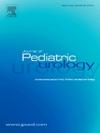Prospective assessment of entrance skin dose and targets for radiation reduction during abdominal plain films in pediatric urology patients
IF 2
3区 医学
Q2 PEDIATRICS
引用次数: 0
Abstract
Introduction
Abdominal radiographs are frequently used for evaluation of bowel and bladder dysfunction in pediatric urology. However, the dose of radiation delivered with each study is estimated from machine settings as opposed to measurement of the true entrance skin dose. In addition, the correlation of radiographic constipation with patient symptoms has been questioned.
Objective
To evaluate the practices for obtaining abdominal radiographs and the true entrance skin dose of radiation for each examination in order to identify targets for radiation reduction.
Study design
Pediatric urology patients were prospectively enrolled from June 2022 through June 2023. Dosimeters were attached to the navel to collect entrance skin doses from single view abdominal x-ray. Estimated doses were compared to measured entrance skin dose as well as patient characteristics. Exam parameters were evaluated to identify targets for radiation reduction.
Results
A total of 75 patients were recruited for this study with a median age of 10.0 years (IQR 6–14). Most evaluations were done to assess for bowel and bladder dysfunction (68 exams, 91%). The protocol for exams was not standardized resulting in 27% of patients undergoing a medium or high dose strength and 55% undergoing 1 or more image. The median estimated dose was 0.63 mGy (IQR 0.3–1.2 mGy). The median measured dose was 0.77 mGy (IQR 0.31–2.01 mGy) which was significantly different than the estimations (p < 0.001). The estimated dose, measured dose and estimate error were all found to be positively correlated with patient characteristics including age and body mass index (See Figure). Increasing age and body mass index also showed a higher likelihood of increased dose strength and image acquisition.
Discussion
The measured entrance skin dose of radiation is significantly higher than prior estimates. The measured dose but also the estimate error increased with patient age and size which is likely related to higher settings used for image acquisition as patients age. Standardized protocols using low dose settings and limiting image acquisition to the pelvis may reduce radiation exposure in children with bowel and bladder dysfunction while providing adequate diagnostic data.
Conclusion
Radiation dose for abdominal radiographs is higher than previously estimated. Older and larger children received higher doses which may be mediated by increased dose strength and image acquisition. Standardization of protocols could lower radiation exposure.
前瞻性评估小儿泌尿科患者腹部平片检查时的皮肤入口剂量和减少辐射的目标
在小儿泌尿科中,腹部 X 光片常用于评估肠道和膀胱功能障碍。然而,每次检查的辐射剂量都是根据机器设置估算的,而不是测量真正的皮肤入口剂量。此外,放射成像便秘与患者症状的相关性也受到质疑。目的:评估获取腹部射线照片的方法和每次检查的真实皮肤入口辐射剂量,以确定减少辐射的目标。自 2022 年 6 月至 2023 年 6 月,对小儿泌尿科患者进行了前瞻性登记。剂量计被固定在肚脐上,以收集单视角腹部 X 射线的入口皮肤剂量。将估计剂量与测量的入口皮肤剂量以及患者特征进行比较。对检查参数进行评估,以确定减少辐射的目标。这项研究共招募了 75 名患者,中位年龄为 10.0 岁(IQR 6-14)。大多数评估都是为了评估肠道和膀胱功能障碍(68 项检查,91%)。检查方案没有标准化,导致 27% 的患者接受了中等或高剂量强度的检查,55% 的患者接受了 1 次或多次影像检查。估计剂量中位数为 0.63 mGy(IQR 0.3-1.2 mGy)。测量剂量中位数为 0.77 mGy (IQR 0.31-2.01 mGy),与估计值有显著差异(< 0.001)。研究发现,估计剂量、测量剂量和估计误差均与患者特征(包括年龄和体重指数)呈正相关(见图)。年龄和体重指数的增加也表明剂量强度和图像采集增加的可能性更大。测得的皮肤入口辐射剂量明显高于之前的估计值。随着患者年龄和体型的增加,测量剂量和估计误差也随之增加,这可能与患者年龄越大,图像采集设置越高有关。使用低剂量设置和限制骨盆图像采集的标准化方案可减少肠道和膀胱功能障碍儿童的辐射暴露,同时提供足够的诊断数据。腹部射线照相的辐射剂量比以前估计的要高。年龄较大和体型较大的儿童受到的剂量较高,这可能与剂量强度和图像采集的增加有关。标准化方案可降低辐射量。
本文章由计算机程序翻译,如有差异,请以英文原文为准。
求助全文
约1分钟内获得全文
求助全文
来源期刊

Journal of Pediatric Urology
PEDIATRICS-UROLOGY & NEPHROLOGY
CiteScore
3.70
自引率
15.00%
发文量
330
审稿时长
4-8 weeks
期刊介绍:
The Journal of Pediatric Urology publishes submitted research and clinical articles relating to Pediatric Urology which have been accepted after adequate peer review.
It publishes regular articles that have been submitted after invitation, that cover the curriculum of Pediatric Urology, and enable trainee surgeons to attain theoretical competence of the sub-specialty.
It publishes regular reviews of pediatric urological articles appearing in other journals.
It publishes invited review articles by recognised experts on modern or controversial aspects of the sub-specialty.
It enables any affiliated society to advertise society events or information in the journal without charge and will publish abstracts of papers to be read at society meetings.
 求助内容:
求助内容: 应助结果提醒方式:
应助结果提醒方式:


